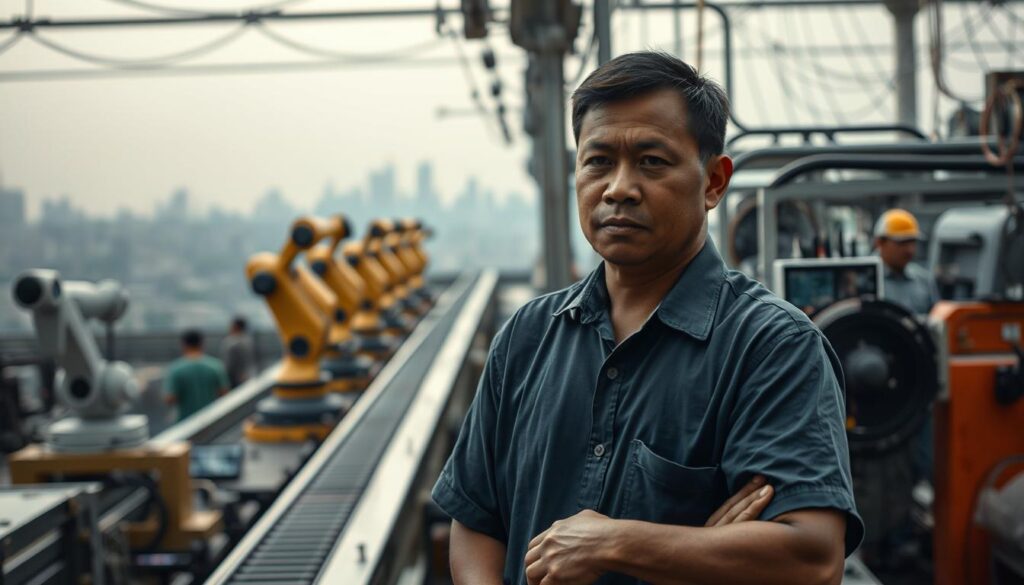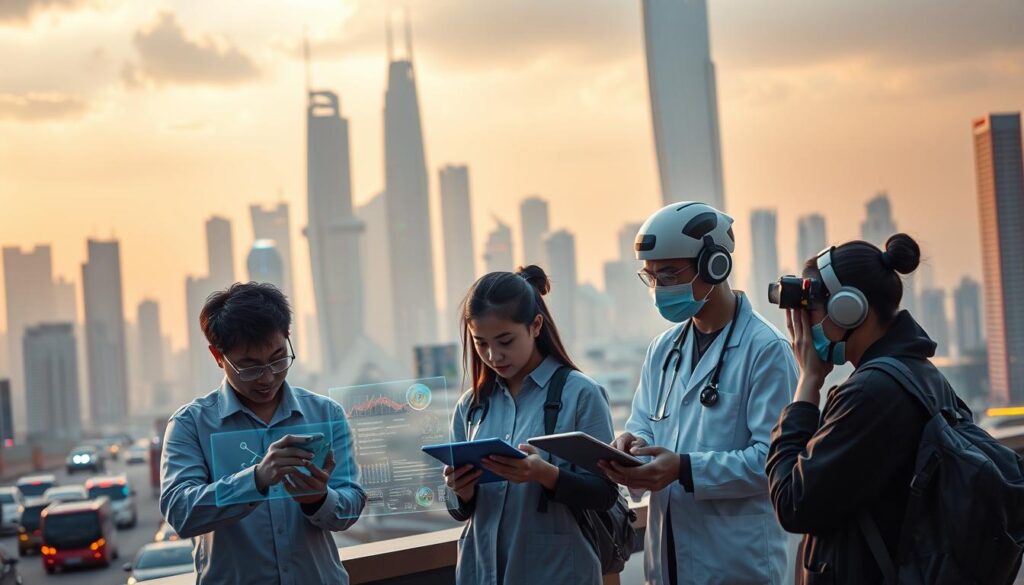Artificial intelligence is changing the workplace fast. In the Philippines, AI and digital transformation are making work better but also changing jobs. Small and medium-sized businesses are learning to use AI to work smarter.
This article will explore how AI is shaping work’s future. We’ll look at what it means for workers and employers.
Key Takeaways
- AI and automation are revolutionizing the way businesses operate.
- Digital transformation is crucial for staying competitive in the modern market.
- Adopting artificial intelligence can lead to significant efficiency gains.
- Understanding the workforce impact is essential for a smooth transition.
- Emerging technologies create both challenges and opportunities for jobs.
- Reskilling and upskilling will be vital for future workforce readiness.
Understanding AI and Automation
Artificial intelligence and automation are changing the workplace. They make work more efficient and productive in many fields, including the Philippines. Knowing what they are and how they’ve evolved helps us see their impact today.
Definition of AI and Automation
Artificial intelligence lets machines do things that humans usually do. This includes learning from data, making choices, and spotting patterns. Automation uses technology to do specific tasks without needing a person. Together, they make work more efficient.
The Evolution of AI Technology
AI technology has grown a lot over time. At first, it was simple and not very useful. But with machine learning, machines started to learn from lots of data. This made AI smarter.
Now, with robotics, automation can handle complex tasks. This is true in fields like making things, healthcare, and moving goods.
Impact on Business Efficiency
AI automation is changing how businesses work in many fields. It makes operations smoother and services better. This leads to cost savings and more output. Companies can stay ahead by using new workplace solutions.
How AI is Transforming Operations
AI is changing operations in big ways. It helps with predictive maintenance, managing inventory, and handling customer relationships. For instance, stores use AI to understand what customers buy and manage stock better. This makes workflows more efficient and boosts business performance.
Increased Productivity in Diverse Sectors
Many sectors, like manufacturing and retail, gain a lot from AI. It automates tasks, freeing up workers for more important jobs. This boosts productivity. Filipino SMEs can also benefit a lot by adopting these new solutions.

AI Automation and the Future of Work
The world of work is changing fast with AI and automation. Companies are focusing on making their workforces better. This means workers will need new skills for their jobs.
Workforce Transition towards Automation
Automation is changing the workplace for many. Old jobs that needed simple tasks are disappearing. Now, people can learn new skills in tech fields.
AI helps people work better, not replace them. Workers need to learn and grow with these changes.
The Role of AI in Job Redefinition
AI is changing what jobs look like. Instead of jobs disappearing, they’re getting better. Now, jobs need more thinking, creativity, and people skills.
New jobs are being created, thanks to AI. Workers who adapt can find great opportunities. Learn more about this in this article.
Jobs at Risk of Displacement
The job market is changing fast because of new technology. Some jobs are at risk because of these changes. It’s important for workers and bosses to know which jobs might be lost.
Occupations Vulnerable to Automation
Jobs that involve doing the same thing over and over are at high risk. This includes data entry, assembly line work, and cashiers. Machines can do these tasks better and faster, which might make these jobs less needed.
Knowing which jobs are most at risk helps everyone plan for the future. It’s key for managing the workforce.
Projected Job Loss Statistics
Studies show that a lot of jobs could be lost by 2030. About 15% of all jobs worldwide might be at risk. In countries like the Philippines, jobs in retail and manufacturing could be hit hard.
Everyone needs to watch these trends closely. Employers and workers must get ready for the changes coming.
| Occupation | Risk Level | Potential Job Loss Percentage |
|---|---|---|
| Data Entry Clerks | High | 60% |
| Assembly Line Workers | High | 50% |
| Cashiers | Moderate | 30% |
| Retail Sales Representatives | Moderate | 25% |
| Administrative Support | Low | 15% |

New Job Opportunities and Growth Areas
The world of work is changing fast, thanks to AI. While some jobs might disappear, new ones are popping up. There’s a big need for people with tech skills, showing where the job market is growing.
Emerging Occupations in the AI Era
AI is changing many industries, creating jobs like data analysts and machine learning experts. These roles are key for businesses and offer new chances in the job market. People who can understand data and create AI models are in high demand.
Growth in Demand for Tech-Related Jobs
In the Philippines, digital transformation is on the rise. This means more jobs in cybersecurity, software development, and AI ethics. As tech becomes more important, these areas will grow, offering great career options for those ready to learn.
Skills Needed for the Future Workforce
The world of work is changing fast. We need new skills for the future. These include advanced tech skills and soft skills. We must learn to work well with technology and in teams.
Advanced Technological Skills
Today, having tech skills like programming and data analysis is key. Automation and AI are doing more tasks. So, we need to know how to use these tools and solve problems with them.
Education programs should teach these skills. This way, people will be ready for jobs in the future.
Soft Skills and Their Importance
Soft skills like creativity, critical thinking, and emotional intelligence are also crucial. They help us work well in teams with AI tools. Being able to communicate and think creatively is important.
Learning and updating our skills is essential. This will help the next generation of workers succeed.

Challenges Faced by Workers
The shift to automated work brings big challenges for workers. As jobs change, many face emotional and financial struggles. Losing a job can make people feel uncertain and worried, making it key to adapt quickly.
Workforce Dislocation and Transition Issues
Workforce dislocation means workers are pushed out of their old jobs by new tech. It’s hard for many, like those in the Philippines, to keep up. The change can lead to barriers, like a lack of support and the emotional toll of being jobless. It takes a team effort from employers, governments, and communities to tackle these issues.
The Need for Reskilling and Upskilling
As automation grows, reskilling and upskilling become crucial. Workers need new skills to succeed in a changing job market. Training in advanced tech, digital skills, and soft skills is vital. It helps people learn for life, making them ready for new roles.
Government and Policy Response
The world of work is changing fast, thanks to AI and automation. Governments must act quickly to help. They need to create plans that help workers and keep the economy growing.
These plans should include training programs. They help workers learn new skills for an automated world.
Investment in Workforce Training Programs
Training programs are key for workers to face the future. Governments can fund these efforts. This helps fill the skills gap caused by new tech.
These programs make sure workers can adapt to new jobs. They learn to work well with AI technologies.
Legal Regulations Surrounding AI and Employment
Legal rules for AI and work protect workers and encourage new ideas. These rules should cover job safety, fair pay, and more. They help everyone trust AI more.
With clear rules, the government can make sure AI benefits everyone. This means employers and employees both get something good.

Case Studies: Philippine Companies Adopting AI
Many Philippine companies are now using AI. This move boosts their work and changes many industries. Looking at these examples shows how businesses are getting better and solving big problems.
Local Examples of AI Implementation
AI is being used in many areas in the Philippines. For example, logistics companies use AI to find the best routes. This cuts down delivery times and costs.
In manufacturing, local businesses use robots to make things faster and better. These changes make companies more productive. They show how AI helps in everyday work.
Impact on SMEs in the Philippines
Small and medium enterprises (SMEs) are also benefiting from AI. They use AI to stand out in a busy market. Successful companies show that AI makes them more competitive and creative.
By using new tools, SMEs can keep up with changes in work. For more on how to automate processes in Philippine SMEs, check out this resource.
Conclusion
As we explore the world of AI and work, it’s clear that tech is key for businesses to stay ahead. In the Philippines, companies using AI boost their work and help the economy grow. They create new jobs and opportunities.
Working together is vital to make the most of tech and solve job loss issues. By training workers, they can meet new job needs. This keeps human skills important, even as machines do more work.
In the end, AI and automation bring both hurdles and chances. By balancing tech and human touch, the Philippines can have a bright future. Businesses will flourish, and workers will be ready for the automated world.

